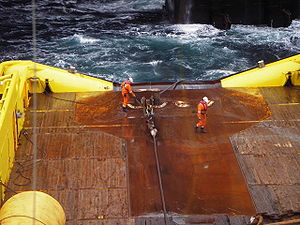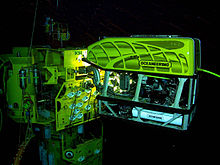| This article needs additional citations for verification. Please help improve this article by adding citations to reliable sources. Unsourced material may be challenged and removed. Find sources: "Anchor handling tug supply vessel" – news · newspapers · books · scholar · JSTOR (February 2017) (Learn how and when to remove this message) |
 AHTS Normand Master alongside the Balder at Thunder Horse Oil Field
AHTS Normand Master alongside the Balder at Thunder Horse Oil Field AHTS Balder Viking handling anchors for the Semi-submersible Platform Transocean ArcticExamples of AHTS vessels
AHTS Balder Viking handling anchors for the Semi-submersible Platform Transocean ArcticExamples of AHTS vessels

Anchor Handling Tug Supply (AHTS) vessels are mainly built to handle anchors for oil rigs, tow them to location, and use them to secure the rigs in place. AHTS vessels sometimes also serve as Emergency Response and Rescue Vessels (ERRVs) and as supply transports.
Many of these vessels are designed to meet the harsh conditions of the North Sea, and can undertake supply duties there between land bases and drilling sites. They also provide towing assistance during tanker loading, deepwater anchor handling, and towing of threatening objects.
AHTS vessels differ from platform supply vessels (PSVs) in being fitted with winches for towing and anchor handling, having an open stern to allow the decking of anchors, and having more power to increase the bollard pull. The machinery is specifically designed for anchor handling operations. They also have arrangements for quick anchor release, which is operable from the bridge or other normally crewed locations in direct communication with the bridge. The reference load used in the design and testing of the towing winch is twice the static bollard pull.
Even if AHTS-vessels are customized for anchor-handling and towing, they can also undertake, for example, ROV (remotely operated underwater vehicle) services, safety/rescue services, and supply duties between mainland and offshore installations.
The world's strongest tug since its delivery in 2020 is MV Island Victory (Vard Brevik 831) of Island Offshore, with a bollard pull of 477 tonnes-force (526 short tons-force; 4,680 kN).
See also
References
- "AHTS". Archived from the original on 17 May 2018.
- "Anchor Handling Tug Supply Vessel". Archived from the original on 12 January 2017.
- "Anchor-handling/tug/supply vessels". Rolls-Royce Marine. Archived from the original on 28 January 2015.
- "MV ISLAND VICTORY". Island Offshore. 11 December 2019. Retrieved 2022-12-31.